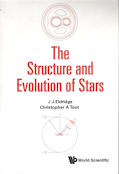The structure of a star can be described mathematically by differential equations which can be derived from the principles of hydrodynamics, electromagnetic theory, thermodynamics, quantum mechanics, and atomic and nuclear physics. The basic equations of a spherical star are derived in detail, the modes of energy transport, the equation of state, the physics of the opacity sources and the nuclear reactions are explained. Approximate solutions of the equations for stellar structure are given. Attention is given to the virial theorem, polytropic gas spheres and homology principles. The procedure for numerical solution of the equations is outlined.
The evolution of a star is described from its main sequence evolution through the exhaustion of various nuclear fuels to the end points of evolution such as white dwarfs, neutron stars and black holes. Supernova explosions as the deaths of massive stars along with nucleosynthesis of elements within stars are explained.
